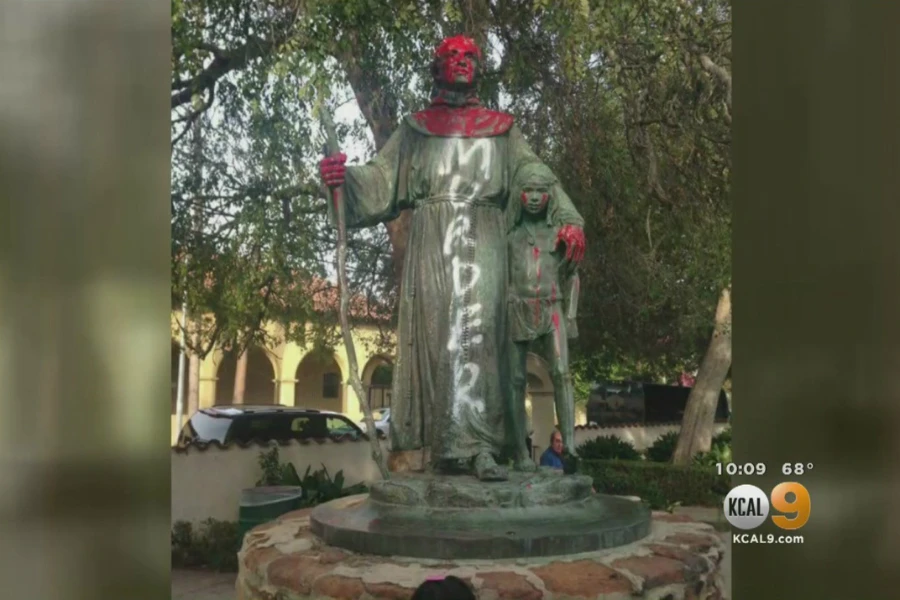
Los Angeles, Calif., Aug 22, 2017 / 12:03 am (CNA/EWTN News).- A statue of St. Junipero Serra in a Los Angeles public park appeared to have been vandalized last week in a time of national debate about historical statues.
The statue portrays the Franciscan friar in a favorable light, with his arm on the shoulder of an indigenous child. The park is across the street from the Mission San Fernando in Mission Hills community of Los Angeles. The mission was founded by Fr. Fermin Lasuen, another Franciscan, in 1797.
A picture of the statue was circulated on social media, showing it spray-painted red with the word “murder” written on the priest in white.
City officials did not confirm to Los Angeles news station CBS2 that the photo was authentic or that the statue was cleaned. However, a CBS2 reporter at the scene said there was red paint on the arm of the priest’s statue and a swastika on the statue of the child.
St. Junipero, a Franciscan missionary from Spain, founded nine Catholic missions in California in the late 1700s. His missions helped convert many native Californians to Christianity and taught them new technologies.
Most of the missions he founded would go on to become the centers of major cities in the state, as did other Franciscan-founded missions. The priest carried on his work despite a painful wound to his leg.
He died in 1784 at Mission San Carlos Borroméo del Carmelo in what is now California
St. John Paul II beatified Father Serra in 1988. Pope Francis canonized the priest Sept. 23, 2015 in Washington, D.C.
“He was excited about blazing trails, going forth to meet many people, learning and valuing their particular customs and ways of life,” Pope Francis said. “He learned how to bring to birth and nurture God’s life in the faces of everyone he met; he made them his brothers and sisters.”
“Junipero sought to defend the dignity of the native community, to protect it from those who had mistreated and abused it. Mistreatment and wrongs which today still trouble us, especially because of the hurt which they cause in the lives of many people,” the Pope added.
In Los Angeles last week, passerby Cristian Mendoza criticized the vandalism.
“Everyone’s entitled to their own public opinions and thoughts,” Mendoza told CBS2. “But once it gets to this level I don’t think it’s right.”
CBS2 quoted another passerby, Christian Ramirez, who said he thought the statue should be taken down and replaced with a statue he thought would show “appreciation to the native people that live here.” He suggested it represented a “violent history.”
Several California legislators have unsuccessfully pushed to remove the statue of St. Junipero Serra from the U.S. Capitol’s National Statuary Hall.
Some of St. Junipero Serra’s critics object to the forced confinement of some indigenous peoples in the missions he founded, as well as corporal punishment inflicted there, saying they are causes to dismiss the saint. Some also criticize his association with Spanish colonialism.
His defenders note St. Junipero Serra’s defense of native peoples at a time when Spanish soldiers and other officials could easily abuse them. At one point, he opposed the death sentence for a man who had killed one of his fellow missionaries in an uprising.
Many native peoples attended his burial and openly wept at his death.
The vandalism of the saint’s statue comes amid controversy over the fate of statues honoring leading figures of the Confederate States of America and the Reconstruction era.
In Charlottesville, Virginia, several hundred demonstrators gathered from around the country on Aug. 11 to protest the removal of a statue of General Robert E. Lee from a city park. The rally drew white supremacists, neo-Nazis, and Ku Klux Klan members. Many waved the Confederate battle flag and at least one demonstrator waved a Nazi flag.
The demonstration was set to continue the next day, attracting many counter-protesters. Both groups skirmished with each other, leading authorities to declare the assembly unlawful and to order the crowds to disperse.
An hour later, one rally attendee, 20-year-old James Alex Fields, allegedly drove into a crowd of counter-protesters, killing 32-year-old Heather Heyer and seriously injuring several others.
The incident prompted many peaceful responses, as well as some attacks on Confederate statues and other public monuments.
A statue of St. Joan of Arc had been vandalized in New Orleans by an unknown person or persons sometime in late April or early May, with graffiti reading “tear it down.” It followed controversy in the city about the removal of monuments to the Confederacy and the Reconstruction era.
In Baltimore, the oldest U.S. statue of the explorer Christopher Columbus, erected in 1792, was also vandalized this month. A video posted to YouTube claiming responsibility for the incident blamed Columbus for “a centuries-old wave of terrorism, murder, genocide, rape, slavery, ecological degradation and capitalist exploitation of labor in the Americas.”
Many such statues were set up by U.S. Catholics in the late 19th and early 20th centuries to mark his role in opening the New World to Europeans, at a time when many leading Americans denigrated Catholic figures.
If you value the news and views Catholic World Report provides, please consider donating to support our efforts. Your contribution will help us continue to make CWR available to all readers worldwide for free, without a subscription. Thank you for your generosity!
Click here for more information on donating to CWR. Click here to sign up for our newsletter.




A great evil, and darkness is spreading around the world, and has been for some time. Maybe (though I doubt it) – this type of physical display is what is necessary to wake up the church which has been in PC Lala land for so long.
Calling people who try to stop it, culture warriors or ecumenical haters, singing Kumbahya, reading anything put out by the USCCB… isn’t going to help